To the 70 anniversary of the counter-offensive. Kalinin offensive

The Red Army counteroffensive near Moscow was the first major offensive in the Great Patriotic War (1941-1945). By the beginning of December 1941, the German forces fought toward the capital of the USSR in fierce battles with the forces of the Western, Southwestern, and Kalinin fronts suffered significant losses, were stretched across a broad front and eventually lost their strike power.
So 1 December 1941, commander of the Army Group Center, von Bock sent a report to the commander-in-chief of the ground forces, von Brauchitsch, in which he reported that he did not have enough strength for a larger maneuver. The fights of the last two weeks have shown that the assumption that "the enemy is" close to defeat "turned out to be an illusion." Army Group "Center" was forced to hold the front approximately 1 thousand. Km and had as a reserve only one weakened division. The German commander wrote that with such an arrangement of forces on the Eastern Front, when the troops suffered heavy losses in the officer corps, and the fighting capacity of the troops fell, the Wehrmacht was unable to conduct more or less planned offensive actions. Due to failures in the railway, the command is also unable to prepare the troops widely on the front for defensive operations and to ensure a full supply of forces during such battles.
Von Bock suggested that if the Army Group Center would have to go on the defensive at the current frontiers for the 1941-1942 winter, then with the current balance of forces at the front, this is “possible only if large reserves are allocated” that will be able to block possible enemy strikes, front breakthroughs. And allow alternately to take to rest and replenish weakened in battle battles of the first echelon. And for this, the army group will additionally need at least 12 divisions. The following prerequisite, in the opinion of the German Field Marshal, was the order and reliable operation of railway transport. This made it possible to regularly supply the German troops and create the necessary stocks (ammunition, ammunition, food, etc.). If it is not possible to strengthen the group of armies with reserves, and restore order in the supply, then it is necessary to immediately select a profitable and less stretched line in the rear for the forces of the Eastern Front. A new frontier must be prepared by the appropriate forces for defense, and the necessary rear communications must be built so that when a corresponding order of the high command is received, it can be taken during a quick time.
Soviet side
For the Soviet command, the Kalinin operational line came as a big surprise. It appeared because of the catastrophe that occurred during the first stage of the October battle on the distant approaches to the capital of the Soviet Union. Then, as a result of the encirclement of the four Soviet armies (19, 20, 24 and 32) of the Western Front, the formation of the so-called. "Vyazemsky boiler" Nazi troops were able to freely move deep into the USSR on the right wing of the Western Front.
As a result, had to spend Kalinin defensive operation (October 10 - December 4 1941 of the year). Active actions by the commander of the troops of the Western Front, General Georgy Konstantinovich Zhukov, who replaced Ivan Stepanovich Konev, the creation of a special group of troops consisting of troops of the left wing of the Western Front and the operational group of the North-Western Front under the command of N.F. Vatutin, and then the Kalinin Front to act on Kalinin direction prevented the disaster. Although Kalinin himself had to give up on October 14. By October 16, Soviet troops with battles retreated beyond the Volga River and fortified themselves at the Selizharovo, Staritsa line. With the capture of the city of Kalinin, the Wehrmacht was able to develop an offensive bypassing Moscow from the north and north-east, as well as to the rear of the North-Western Front. October 17 was ordered to form the Kalinin Front of 4 armies: 22, 29, 30, 31st and a number of separate units. Germans, and in this direction the 9th Army and the 3rd tank group, and had superiority in manpower and equipment (in infantry 1,9 times, tanks in 3,5, guns in 3,3, in machine guns - 3,2 times), they could not develop the offensive.
A few days went fight for the city of Kalinin. Part of the 256 th rifle division of General S. G. Goryachev and the Kalinin national militia detachment under the command of Senior Lieutenant Dolgoruk, held the north-western part of the city. Task Force N.F. Vatutina reflected the attempt of the 41-th motorized corps of the 3-th tank group to break through to the rear of the North-Western Front. Reflected a blow in the Torzhok direction. After continuous and bloody battles, which, although they did not bring the Red Army significant territorial success, parts of the Wehrmacht were exhausted, suffered significant losses in people and technology. Kalininsky front active defense and constant counterattacks forged 13 enemy divisions and did not allow them to transfer to the Moscow direction, where the decisive battle took place. By December 4, the troops of the front were firmly entrenched on the line east of Selizharov, north of Martynov, west, north and east of Kalinin, the left bank of the Volga, Volga reservoir. The Kalininsky front occupied a covering position in relation to the northern flank of Army Group Center, which was advantageous for a counteroffensive.
Preparing the offensive
In the course of planning a general offensive near Moscow, a decision was also made to strike the Kalinin front. Lieutenant-General A. M. Vasilevsky, Deputy Chief of the General Staff, told 1 of December the commander of the Kalinin Front, Colonel-General I. S. Konev, about the "exceptionally favorable operational position" of the front and the need to "literally collect everything to strike the enemy."
On 1 December 1941, the correlation of forces on this sector of the Soviet-German front was as follows: the Soviet forces were opposed by the 9 German army under the command of Colonel-General Adolf Strauss as part of the 12 infantry divisions, the 1-th guard division, and 1-th cavalry. "SS". Its number was about 153 thousand people, the Germans had about 2200 units and mortars, tanks - 60. In the Kalinin front there were about 200 thousand people, approximately 1000 guns and mortars, 17 tanks. The ratio in manpower of 1,5: 1 in our favor, in terms of guns and mortars, we were inferior - 1: 2,2, in tanks - 1: 3,5.
December 1 Supreme Command Headquarters (UGHK) issued a directive on the offensive actions of the front. The headquarters ordered the creation of an attack group of at least 2-3 divisions over the next 5-6 days and strike from the front Kalinin, Sudimirka in the direction of Mikulino Gorodishche and Turginovo. The strike group was supposed to go to the rear of the Klin group of Wehrmacht and thereby contribute to its destruction by the troops of the Western Front.
In the morning of December 1, Lieutenant General A. M. Vasilevsky arrived at the front to clarify the situation. It turned out that I. S. Konev, considering his limitations in forces and means, and decided instead of an operation with a decisive goal, which envisaged a victory over the right wing of Army Group Center, in cooperation with the Western Front, to conduct a local operation to liberate the city of Kalinin. A. M. Vasilevsky was able to convince the front commander that the Stakes plan was real. Konev only asked to strengthen the front.
By order of the Supreme High Command, a regrouping of the forces of the Kalinin Front was carried out. The 31 Army under the command of Major General V. A. Yushkevich gave up a significant part of the front line (including the city of Kalinin) to the 29 Army. All units of the 31 Army were concentrated in the 30-kilometer zone - from Kalinin to Sudimik. 2 December 1941, the front commander Konev, in accordance with the directive of the Supreme Command Headquarters, issued a combat order to the troops. The front should have delivered two hits. The first forces 31-th army from the east and southeast of Kalinin. The second connections 29-th army under the command of Lieutenant-General I. I. Maslennikov bypassing Kalinin from the west. The 29 Army was also supposed to defend the Torzhok direction.
The offensive was planned for the 2 phase. At the first stage, the formations of the 29 and 31 armies should have penetrated the German defenses on the first day of the attack and captured Kalinin. Then the advancing troops of the armies were to go onto the line: Danilovskoe, Negotino, Stary Vohost, Kozlov. At the second stage, the troops of the front were to develop success in a southerly direction and by the attack group reach the line of the Shoshi river.
The commander of the 31 Army, Major-General V. A. Yushkevich, decided to deliver the main blow at the 6-kilometer sector with units of the 119 (Major-General A. D. Berezin) and 250 (Col. P. A. Stepanenko) rifle divisions in the direction of Stary Vohost, Pushkino. For the development of a breakthrough in the reserve of the 31 Army, the 262 Division was ridden (Colonel M. S. Tereshchenko). At the same time, in order to divert the attention of the German command, it was planned to conduct two auxiliary attacks: the 256-Infantry Division attacked the Great Pemerki with its right flank, and the 5-Infantry Division beat at Smolino Gorodishche. Thus, the 31-th Army of Yushkevich, having rather limited forces — the army did not receive new divisions in its structure and launched an offensive with the units that had thinned in previous battles, inflicted not one blow, but three. In addition, it was not possible to suppress the defense of the Germans with strong artillery fire: the density of artillery in the direction of the main attack of the 31 army was only 45 units on 1 km of the front.
Within a very short time, the front carried out a rather significant regrouping of forces. All troop movements were carried out at night, with careful disguise. The Germans, apparently, were so confident in their power that they oversaw the preparation of the front for the counterattack, and, as the prisoners later said, the offensive of the Soviet troops was completely unexpected for them.
The Germans had a fairly solid defense, a chain of trenches and long-term protected firing points stretched along the Volga. In some places, the river bank was cut steeply and watered. Therefore, to climb under the fire of the enemy on a slope covered with ice was almost impossible. The Germans turned the villages in the forefront and in the depth of their defense into strong strongholds, and the stone and the most powerful wooden buildings into long-term firing points with circular shelling. The gaps between the strong points were covered with minefields and two or three lines of wire barriers. In the city of Kalinin, the enemy created a solid line of defense from the trenches, bunkers and dugouts.
Due to the fact that the 262-Infantry Division did not have time to reach the initial positions and the rear did not have time to pull up, the beginning of the offensive front was changed and transferred from 4 to December 5 of 1941.
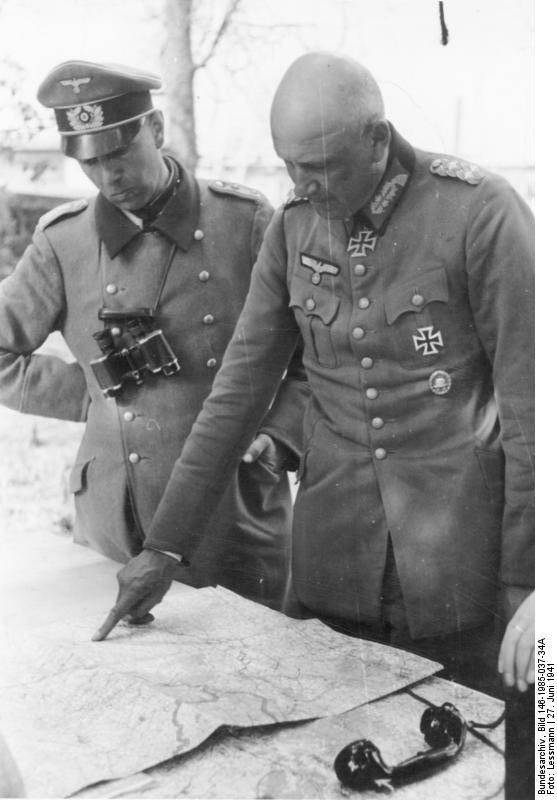
Adolf Strauss (right) 9 Army Commander
Offensive
December 5 army Kalinin Front launched a counter-offensive. Following them in the morning of December 6, the strike forces of the Western Front and the right wing of the Southwestern Front launched an offensive. Fierce battles took place on the front of more than 1000 km (from Kalinin to Yelets).
At 3 hours of the night 5 December, the assault battalions of the divisions of the 31 Army assault group marched across the ice to the right bank of the Volga in order to capture bridgeheads in Pemerki, Gorokhov, Staro-Semenovskoye settlements with the main forces of the army to overcome the water line. The 119 and 5 battalions of the infantry divisions captured the bridgeheads at Gorokhov and Staro-Semenovsky for 10 hours.
At 13 hours after 45 minutes of artillery fire and strikes aviation the main forces of the army went on the offensive. From the very beginning, the battle assumed a fierce character. Rifle companies, which attacked virtually without the support of armored vehicles, were able to overcome the Volga with one throw, but on the other side came under heavy enemy fire. But, despite the mortal fire of the Germans, the Red Army bravely rushed to seize the settlements of Gorokhov, Gubino, Emmaus, Staraya Vedernia, Aleksino. Grenades were used, and it also came to hand-to-hand fights when they used bayonets, butts, and knives. In fierce battles, by the end of December 5th, formations of the 31st Army were able to break through the first line of defense of the 9th German Army, they cut the Moscow-Kalinin highway. Soviet troops advanced 4–5 km, advanced units came right up to the October Railway. In total, 15 settlements were captured during the first day of the battle. But the troops of the 31st Army could not fully fulfill the task set by the front commander.
In 11 hours of 5 December, in the general direction to Danilovskoye, Lieutenant-General I. I. Maslennikov's units of the 29 Army went on the attack. The troops of 246 (Major General I. I. Melnikov) and 252 (Colonel A.A. Zabaluev) rifle divisions, switched to the Volga 14 watch, and entered the Krasnovo-Migalovo road. The 243 Rifle Division (Major General V. S. Polenov) advanced to the northern outskirts of the city, having met strong German resistance. More than the division could not do. The Wehrmacht, fearing for its rear, provided fierce resistance to the units of the 29 Army, constantly switching to counterattacks. Therefore, the compounds of the 246 and 252 divisions of the rifle divisions were forced to withdraw to the left bank of the Volga. And even by the end of the fifth day the battles actually remained at the very turn from which they began the offensive. The 243-Rifle Division received an order not to get involved in heavy street fighting in the city of Kalinin and to confine itself to reconnaissance in battle and leading artillery and mortar fire on the defensive positions of the Germans.
The offensive of the 31 Army almost collapsed. Part of the army 6-7 December fought fierce battles on the reached lines. Already on the night from 5 to 6 December, the German command transferred considerable reserves to the breakthrough site and in the morning the Nazis launched strong counterattacks, and as a result the Germans managed to recapture the settlements of Myatlevo, Oshchurkovo, Emmaus. A connection 250 th Infantry Division, which has achieved 5 December most success, were forced to withdraw to the left bank of the Volga. The main reason for this failure was the mistakes of commanders and the lack of reliable communications in the division. On the morning of December 6, one of the battalions of the 922 Infantry Regiment was deployed to repel an attack by a German group that threatened the flank of the neighboring 5 Division. The 916 and 918 regiments considered that this was a departure from the Kuzminskiy, they faltered and began to depart. The panic began. The command of the Wehrmacht took advantage of this mistake and threw in their counterattack. Control was lost in our retreating regiments. Unorganized mass retreat led to significant losses (about 1,5 thousand people killed, wounded and missing). The division command lost control of the situation.
In order to restore the situation, the commander of the 31 Army introduced a reserve 6 - 262-Infantry Division into the battle in the second half of the day. The command of the retreating regiments was punished: the military tribunal sentenced for unauthorized withdrawal from their positions, the commander and commissar of the 918 regiment, the commissar of the 916 regiment to death, the commander of the 916 th regiment of imprisonment.
With the help of the 57 th pontoon-bridge battalion near the village of Orshino, two pontoon crossings were created, they were laid directly on the ice, because it was impossible to organize a ferry crossing because of the severe frost. All day December 6 were stubborn battles for crossing the river. With the help of aviation, the Germans managed to destroy the Orshino ferry, but at Poddubya, on the night from 6 to 7 December, they were able to transport part of the artillery of the RVGK and 6 T-34 tanks to the captured bridgehead.
December 7, after the 15-minute artillery preparation, the offensive was continued. After a fierce battle, the troops of the 31 Army were again taken over by Emmaus, who was an important stronghold on the Moscow-Kalinin highway. And on December 8, Soviet troops reached the Klin-Kalinin railway and beat off the Chupriyanovka railway station. On the right flank of the army, units of the 256 Infantry Division also entered the railroad.
It should be noted that from the very beginning of the offensive there was a strong frost - 30 – 33 °. And in the morning 8-th went heavy snow, which brought all the paths and roads. If the field guns could be moved because the sled was prepared for them in advance, the motor transport was sticking to it. And the compounds had to bring ammunition, fuel, food, fodder. In this respect, the local population has been a great help, and it has supported horses and sleds. The German command, taking into account the weather conditions that hampered the possibilities for maneuver, concentrated all forces on the defense of settlements, which had been converted into fortifications in advance.
December 9 31 army troops on their right flank captured Koltsovo stronghold. Kuzminskoe was liberated in the central direction. The 256 Rifle Division by the end of the day cut the Turginovo-Kalinin highway 1,5 km east of Mozzharin. For 5 days of heavy offensive fighting, the army marched forward 10 – 12 km and practically broke through the entire tactical defense zone of the German army.
But one cannot say that everything was going well - part of the 29 army could not liberate Kalinin. The 31 Army, reinforced by a single rifle and 1 Cavalry Division, advanced slowly. The German command understood that the rapid movement of parts of the Kalinin Front in the southwestern direction could eventually lead to a catastrophe for its 3 and 4 tank groups, which at that time retreated under pressure from the troops of the Western Front. Therefore, under the Kalinin 129-I infantry division was redeployed, which was removed from the Moscow direction, as well as 110-I and 251-I infantry divisions (they acted against the forces of the right wing of the front).
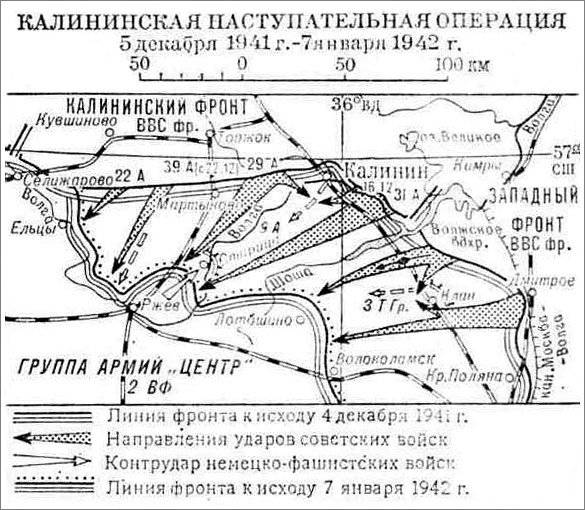
Order of the WGH Bet, Front Enhancement
Due to the slow movement of the Kalininsky front troops, the Supreme Command headquarters ordered to turn part of the 31 army formations bypassing Kalinin from the southeast and, in cooperation with the 29 army, immediately repel the city, and develop the advance to the southwest in the rest of the 31 army and together with parts of the Western Front to defeat the enemy.
The liberation of the city made it possible to free the forces connected in this area and to direct them to strike the rear of the Wehrmacht group that was retreating from the capital. In addition, this step made it possible to resume the railway communication on the section Moscow - Bologoye - Malaya Vishera, which was of strategic importance.
Taking into account the large role of parts of the Kalinin Front in the course of the further development of the offensive operation near Moscow, the Supreme Command headquarters conducted significant measures to strengthen it. To strengthen the front were transferred 359-I and 375-I infantry divisions. Parts of these 12 divisions of December began to arrive at the Kulitskaya railway station (in 15 km north-west of Kalinin). At the same time, the Supreme Command headquarters informed Konev of the transfer of the 39 Army to the Kalinin Front (as part of the 6 infantry and 2 Cavalry Division) for entering it into battle on the Rzhev or the Old Town directions.
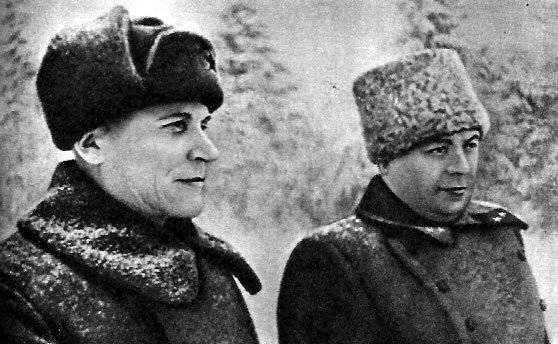
Further fights. Kalinin's release
To complete the encirclement of the Germans, the commander of the 31 Army created a strike group. It includes the 250-I, 247-I divisions, 2 regiment of the 119 th rifle division, 2 tank battalion, 2 artillery regiment of the RGK (reserve of the main command) and other units. But she could not hit right away - during the 13 December, the shock group had to repel strong German counterattacks at the previous frontier. Before the 6, German battalions with four tanks broke through to the rear of the 247 Infantry Division and attacked its headquarters. The division commander was wounded. As a result, control of parts was lost for some time. Army headquarters regained control, and the German battalions that had broken through were destroyed.
By the end of December 14, for the third time during the offensive, part of the 246 th Infantry Division of the 29 Army defeated the German settlement of Krasnovo from the Germans. 31-I army developed the offensive, was cut Volokolamsk highway. In the center and on the left flank of the army, Soviet troops also successfully advanced. The 262-Infantry Division, reflecting up to six German counterattacks, by the end of the day captured strong fortified points Baksheevo and Old Pasost. 5-I Infantry Division entered the line: Trunovo, Mezhevo. 46-th cavalry division was launched in the area of Trunov for the raid on the German rear. To increase the offensive of the army was transferred 359-I Infantry Division.
After the 31 Army units cut down the Volokolamsk Highway, the fate of the Wehrmacht Kalinin grouping was resolved. The German troops remained only one way to withdraw: Kalinin - Staritsa. In addition, the departure of the 30 Army of the Western Front to the line of the Lama created a great threat to the rear of the German 9 Army. Therefore, realizing that the city could not be defended, the Germans began to prepare for withdrawal — in the evening of 15, arson began, on the night of the 16, the Germans destroyed the highway and railway bridges across the Volga.
Breaking down the resistance of the Nazi rear units, the 243 Infantry Division's 29 Infantry Division's connections to the 3 December 16 hours liberated the northern part of Kalinin, and made their way to the 9 hours near the railway station. By 13 hours the city was completely liberated from the Germans.
Results of the first stage of the operation
- During the 12 days of offensive battles, the forces of the left flank of the Kalinin Front defeated the Wehrmacht 5 infantry divisions, which accounted for almost half of all troops of the German 9 field army. During the 5 - 16 period of December, over 10,000 German soldiers and officers were destroyed by Kalinin Front units. 7 tanks, 14 vehicles, 200 guns and mortars were captured.
- Kalinin suffered heavy destruction, the Germans destroyed 70 factories, plants and workshops, the best city buildings were destroyed or burned: the regional and city Soviets, the regional committee and city committee of the party, the drama theater, the theater of the young spectator, cinemas, 50 schools, 7,7 thousands of residential buildings, more than a hundred shops, 25 canteens. Significant damages were received to power stations and railway junctions, the water supply and sewerage network, tram lines, telephone communications, etc.
- Victory at Kalinin became a major operational success of the Red Army. This success ensured the movement of the troops of the right wing of the Western Front. More favorable conditions were created for the continuation of the offensive of the Kalinin Front in a southwesterly direction. The front flank connections pushed forward on 10 - 22 km. The rate of advance of the troops of the front was relatively small. The reasons for this were quite understandable: the almost complete absence of armored vehicles (especially at the beginning of the offensive), the lack of artillery, ammunition, vehicles and other means of material and technical support of the troops. The units of the advancing armies were not replenished and reinforced with fresh units before the offensive. There were also shortcomings in command and control, and in the field of communications. During the offensive of the Kalinin front armies, the interaction of the formations was disrupted, the task setting often exceeded the potential capabilities of the divisions, frontal attacks of strongholds and fortified positions of the Germans were used instead of bypassing and blocking them. It is necessary to take into account the fierce resistance of the 9 of the German army.
Completion of the Kalinin offensive
By the end of December 16, the connections of the left flank of the Kalininsky Front took to the line: Motavino - Kurkovo - Maslovo - Boldyrevo.
The further development of the offensive took place under the conditions of fierce resistance by the Nazis and a harsh winter, with a general lack of military equipment and transport among the Soviet troops. The Kalininsky front did not have large tank and motorized formations that could develop success, reach the operational space, shatter the German army’s construction to a greater depth and quickly complete their encirclement and then liquidate its groups. The offensive of the Soviet units was of a frontal character, the shock groups were not created everywhere. The pace of movement of the troops of the front were low. The German command managed to withdraw most of the troops.
After the liberation of Kalinin, the front was tasked to continue the vigorous pursuit of the Nazis in the direction of Staritsa, to get out of the way of the withdrawal of the Kalinin group of Wehrmacht, to surround and liquidate it.
Carrying out this task, the troops of the Kalinin Front (and it was reinforced by the 30 Army from the Western Front and the 39 Army from the Supreme Command Headquarters reserve), 1 January 1942, overcoming the stubborn resistance of the Germans, liberated Staritsa, the regional center of the Kalinin Region. Then, the Soviet troops reached the approaches to Rzhev and Zubtsov and by January 7 occupied profitable frontiers with respect to the Rzhev group of the Wehrmacht. So was completed Kalinin offensive.
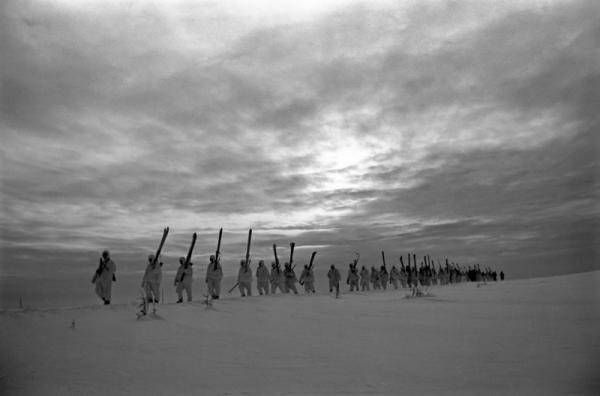
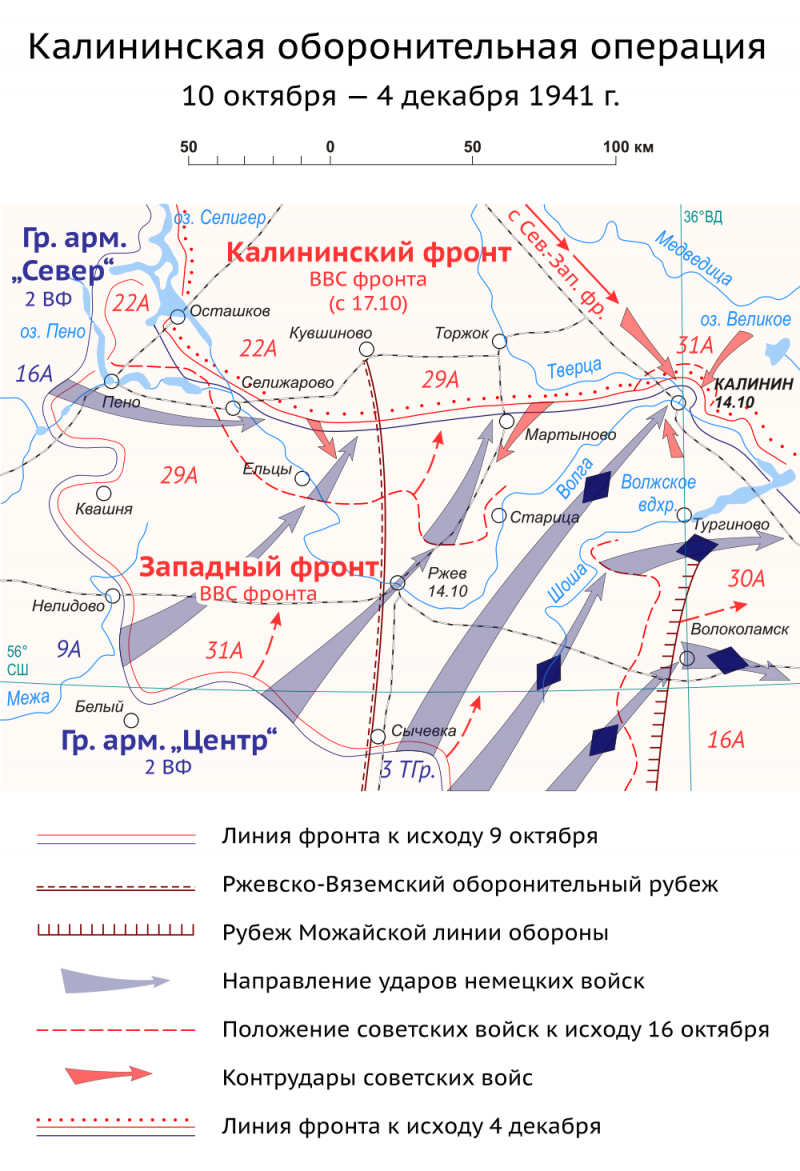
Information